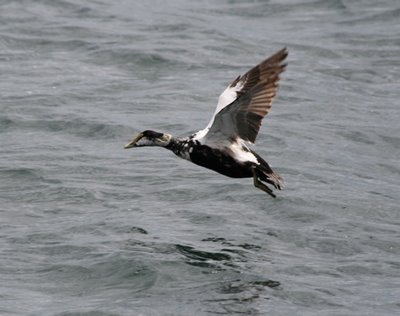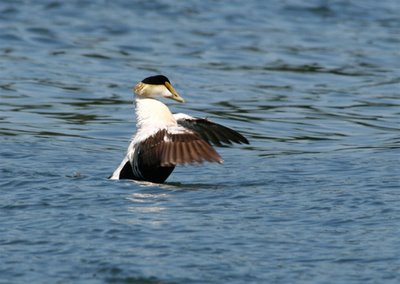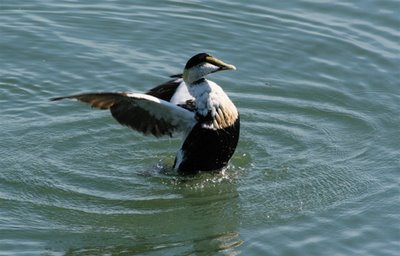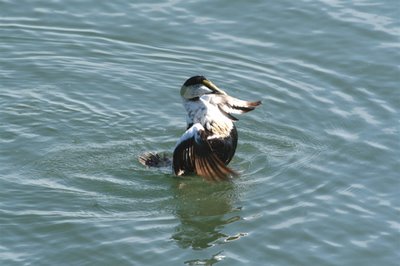Uncommon Eiders
Common eiders are big ducks, adapted to deep diving and processing mussels and other bivalves with their powerful gizzards. They are supremely well-insulated, spending summers and winters in cold North Atlantic waters. They get on with courting in what seems like midwinter, and by the time the hens lay eggs in spring, the males’ work is done. So here it was, early June, and the drake eiders were already molting out of their nuptial finery and looking pretty patchy.

I don’t know why I wanted to shoot pictures of an eider in nice plumage. Molting eiders are still eiders, but… I got plenty of opportunities to shoot molting males. When this nearly immaculate drake decided to spend the afternoon bathing and preening in easy shooting distance of the Hog Island shore, I grabbed the chance.

He fluffed and splashed and kept rising up to beat his beautiful wings. There’s a faded citrus-green on the back of a drake eider’s head that is hard to find anywhere else in the bird world. And I’ve thought about it, but I can’t guess the function of the fleshy processes that run from the bill toward the eye. Maybe they just look cool to female eiders.
The females make the most amazing nests, great rings of thick mocha-brown down over a grass-lined depression in the ground. They pull the down from their breasts, and draw it over the eggs like a blanket when they have to leave to feed. No help from the drake! If a female eider is surprised on the nest, she’ll evacuate the foulest contents of her caecum onto the eggs. Even a hungry fox may refuse eggs so anointed.
 I skinned a drake eider once. Two inches of feathers and a thick layer of fat covered a dense, strongly muscled body. The gizzard of an eider can take a clam and reduce it to liquid. When I got the skin cleaned and sewed it back over the cotton body I’d fashioned, that bird looked like the nicest sofa pillow you could want. I understood why people made feather muffs and blankets of eider skins, sewn together.
I skinned a drake eider once. Two inches of feathers and a thick layer of fat covered a dense, strongly muscled body. The gizzard of an eider can take a clam and reduce it to liquid. When I got the skin cleaned and sewed it back over the cotton body I’d fashioned, that bird looked like the nicest sofa pillow you could want. I understood why people made feather muffs and blankets of eider skins, sewn together. I’m glad those eider-using days are over, except for some Inuit artisans, because the common eider is declining throughout Maine. They can’t raise young around the abundant and voracious greater black-backed gulls, which pick their ducklings out of the water as soon as they’re hatched. I'll think more about this unfortunate situation in my next post. Not trying to be a downer, understand: just hoping to sound an alarm for a signature bird of the Maine coast.
I’m glad those eider-using days are over, except for some Inuit artisans, because the common eider is declining throughout Maine. They can’t raise young around the abundant and voracious greater black-backed gulls, which pick their ducklings out of the water as soon as they’re hatched. I'll think more about this unfortunate situation in my next post. Not trying to be a downer, understand: just hoping to sound an alarm for a signature bird of the Maine coast.Labels: common eider, eider decline, eider molt





